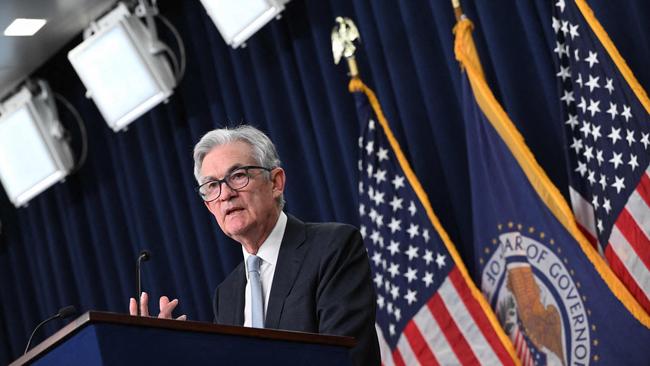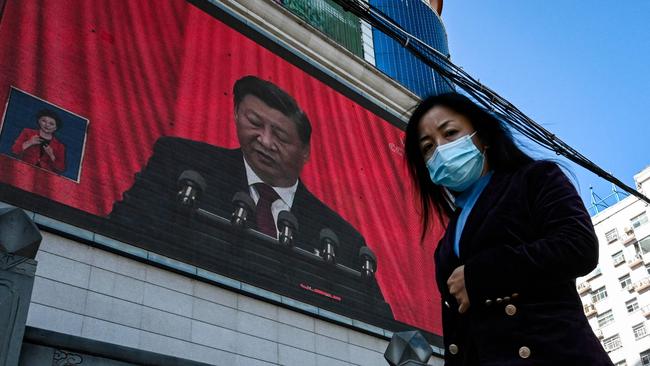US Federal Reserve chair Jerome Powell jawbones consumers to slow inflation
Markets may soon look through Federal Reserve chair Jerome Powell’s attempts to fine-tune US financial conditions.
Markets may soon look through Federal Reserve chair Jerome Powell’s attempts to fine-tune US financial conditions.
His comments on the risks of not doing enough to combat inflation, together with his vagueness on whether smaller rate hikes would start next month – and his decision to flag an up-shift in US interest rate projections in the December “dot-plot” – sparked sharp falls in US and Australian sharemarkets.
But Mr Powell’s comments should be seen in the context of a Fed that wants to prevent a premature loosening of overall US financial market conditions when it starts to slow the pace of hikes, to guard against a “hard landing” after a massive 375 basis points of rate rises since March.
Barring a hard landing in the US, which isn’t evident yet, the Fed might have its work cut out to stop a strong rise in the sharemarket over the next six to 12 months.
November is normally one of the strongest months of the year for US equities.
Moreover, the seasonal pattern for the S&P 500 is positive for the next six months.
On top of that, US midterm elections are due next Tuesday.

The S&P 500 normally rises about 20 per cent in the year following midterm elections.
Bell Potter’s Richard Coppleson said the Fed is “just trying to jawbone the market and consumers into being a bit more worried, and thus slow spending and inflation. But no matter how you look at it, the Fed are now 75 to 80 per cent through their rate hike process and a pivot (to smaller hikes) is now closer – possibly at the December meeting.”
If the Fed funds rate is set to peak near 5 per cent, as projected by market pricing, “it’s now a lot closer to the finish line than they were in March when they started”, he added.
“If that number in any way comes back from there and were to go lower, we’ll see a massive rally. A US recession, though, can change everything very quickly – but for now the bears are hoping that this fall accelerates into something nastier.”
Of course, shares were vulnerable to a short-term dip after the S&P 500 rose 8 per cent in October. Much of that rise was driven by the Fed flagging that it would deliver another 75 basis point hike in November as expected, but signalling a slowdown to 50bps hikes in December. A slowdown in hikes was basically confirmed by the Federal Open Market Committee statement.
It said that while “ongoing increases in the target range will be appropriate”, the Fed will “take into account the cumulative tightening of monetary policy, the lags with which monetary policy affects economic activity and inflation, and economic and financial developments”.

But whereas the Wall Street Journal said the Fed was planning to raise its interest rate projections as a way of controlling a potential loosening of financial conditions, Mr Powell all but confirmed the dot plot will also be revised up in December.
He also made some surprisingly hawkish comments.
The time to slow the pace of rate hikes “is coming, and it may come as soon as the next meeting or the one after that”, Mr Powell said in his press conference.
But recent economic data suggest the Fed may “ultimately move to higher levels than we thought at the time of the September meeting”.
He also said that from a “risk management standpoint … if we were to overtighten, we could then use our tools strongly to support the economy, whereas if we don’t get inflation under control, because we don’t tighten enough, now we’re in a situation where inflation will become entrenched, and the costs – the employment costs in particular – would be much bigger potentially.” Mr Powell added that the Fed wanted to ensure it doesn’t “make the mistake of not tightening enough, or loosening policy too soon. It is very premature to be thinking about pausing.”
“So people when there hear (of) lags, they think about a pause – it’s very premature in my view to think about or be talking about pausing our rate hike. We have a way to go,” he said. “We need ongoing rate hikes to get to that level of sufficiently restrictive.”
Pepperstone’s head of research, Chris Weston, said Mr Powell showed “he’s no friend of the stockmarket”.
“The ‘Don’t fight the Fed’ manta has been reinforced, but that trade over the medium-term means maintaining a long US dollars and short risk bias,” he added.
“I do question if the market has a slight rethink and sees Powell’s presser through a different lens in the session ahead.
“It’s not just about a pause in US rate hikes, but China reopening, potentially in the March quarter.”
While hostage to Beijing’s hard-line Covid-19 management policies for now, a reopening of China would cause a “bottoming in global growth, triggering a US dollar fall that gets the cash off the sidelines”, he said.








To join the conversation, please log in. Don't have an account? Register
Join the conversation, you are commenting as Logout